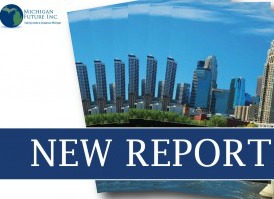Many states, including Michigan, have embraced low taxes and small government as their strategy to try to grow their economies.
Minnesota has long trod a different path, one that features high taxes and smart investments in areas such as transportation, cities and education.
It also has the strongest economy in the Great Lakes region and ranks among the wealthiest states in the country, as Michigan Future has documented in its studies and blog posts.
The state repudiates the notion that high taxes are inherently harmful to economic growth.
The exact opposite is occurring in Minnesota, which like Michigan is a cold-weather state.
Minnesota’s real per capita income in 2012 was $46,227, an eye-popping $8,730 more than Michigan’s per capita income of $37,497. Minnesota ranked 11th in per capita income in 2012, far above Michigan at 35th.
And Minnesota’s job market is much healthier than Michigan’s. Its jobless rate in April was 4.7 percent, while 7.4 percent of Michigan’s residents were unemployed in April.
Perhaps a more important measure is the percentage of adults who are working or available to work. Minnesota had the third-highest labor force participation rate in the country at 70.6 percent in March. Just 60.4 percent of Michigan adults were in the labor force that month, well below the U.S. average of 63.4 percent.
The North Star State has achieved this enviable record with a hefty tax burden that those in the home state of “Prairie Home Companion” host Garrison Keillor sometimes joke about.
“Minnesota residents pay some of the highest taxes in the country and give what’s left over to Minnesota Public Radio,” cracked Dane Smith, president of Growth & Justice, a progressive research and advocacy group in St. Paul.
State taxes alone were $3,880 per capita in Minnesota in 2013, 53 percent above Michigan taxes per capita of $2,535.
Minnesota ranks 6th in state taxes per capita, while Michigan ranks 26th, according to the Federation of Tax Administrators.
At the heart of Minnesota’s tax system is a belief that the wealthy should pay a higher percentage of their income than those on the lower rungs of the income scale.
Minnesota has a progressive personal income tax system in which tax rates range from 5.35 percent to 9.85 percent. The top rate was boosted in 2013 from 7.85 percent, part of a plan to raise an additional $2.1 billion in tax revenues over two years.
In Michigan, everyone pays a flat tax rate of 4.25 percent.
Minnesota businesses also pay much higher taxes than their Michigan counterparts. Minnesota’s corporate income tax rate is 9.8 percent, compared to Michigan’s 6 percent rate.
Both states apply their corporate income taxes to only “C” corporations. But all other Minnesota businesses are subject to a “minimum fee” ranging from $100 to $5,000. That state collected $1.7 billion in business taxes in 2013, compared to $735 million in Michigan business tax revenues.
Minnesota also raises far more money than Michigan does for roads, bridges and public transit. The state taxes gasoline and diesel fuel at 28.6 cents a gallon, 9.6 cents a gallon more than Michigan’s 19 cent-a-gallon gasoline tax. Michigan taxes diesel fuel at 15 cents a gallon.
Total transportation taxes in Minnesota last year were $391 per capita compared to Michigan’s $232 per capita.
Michigan is engaged in a legislative debate over whether to boost road taxes by more than $1 billion a year to fix its rapidly crumbling roads.
The sales tax in Minnesota also is higher than in Michigan—6.875 percent in Minnesota compared to 6 percent in Michigan.
A variety of local units in Minnesota, including schools and local governments, are permitted to assess a local sales tax. Depending on where they live, Minnesota residents can pay a sales tax rate of as much as 7.875 percent.
As in Michigan, there is a debate in Minnesota over the optimal level of taxation. The business community, in particular, has long complained that high taxes make Minnesota less attractive to new investment.
But Minnesota’s high per capita income and strong job market make it difficult to argue that the state is on the wrong path.

Read Michigan Future’s latest report here.







